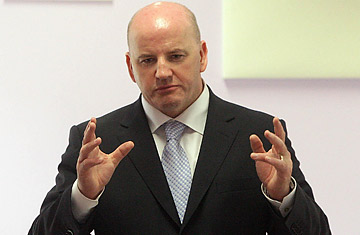
Irish presidential hopeful Sean Gallagher speaks in Dublin on April 10, 2011
With days to go before Ireland votes on its next President, political novice Sean Gallagher is outside a supermarket in Ashbourne, northeast Ireland, where thousands of commuters are struggling with loans on homes that have lost half their value in just the past few years. The election's front-runner quickly and firmly shakes the hands of mothers, seniors and young people and listens to how the recession has hit them, asking the owner of a newly opened grocery store — a rare entity in this economy — if her shop has been busy.
The success of the 49-year-old entrepreneur and independent candidate's campaign has been a surprise — but it has not been the only one in this race. The Oct. 27 vote to replace the popular Mary McAleese as Ireland's head of state has seen the biggest and most diverse field of candidates ever, including four independents.
The role of Irish President is largely symbolic. But these days, with Ireland beaten down by debt and its international reputation stained by failure, there is more riding on this election than there has been in a long while. "It's a high-profile ambassadorial role but is a significant symbol of how Irish people perceive themselves and how they are perceived," says political analyst Noel Whelan.
The past two Presidents have breathed new life into the role — both by using the office's soft authority to set agendas and by personifying changes in Irish society. As the country's first female President, Mary Robinson embodied a shift away from the state's long-held social traditionalism and used the role to champion human rights, while as the first Ulster-born President, McAleese stood for a move away from the northern Troubles by connecting with Ulster Protestants and warmly welcoming Queen Elizabeth II in a historic visit earlier this year. Many of the current candidates promise to build on and continue those themes of social change and peace building, but voters in a country profoundly altered by economic realities may be hoping for a thoroughly different vision.
The next President will have to fix a reputation left in tatters by a financial meltdown and the low morale from a humiliating E.U.-IMF bailout and 14% unemployment. Ireland's economy has been through dramatic highs and lows since the last presidential election in 1997. It's gone through rapid economic growth, from becoming one of the wealthiest countries in Europe with near full employment in 2005 to experiencing a sharp recession since 2008 when the property bubble burst and banks had to be rescued, culminating in a $118 billion bailout for the state and a 15% drop in GDP in the period.
The anger that the public expressed in February's national elections, when the Fianna Fail party (which had been in power for 14 years) was voted out for ruining the economy, may re-emerge to favor nonmainstream candidates this time — especially since the newly elected government coalition of Labour and Fine Gael has failed to turn things around and is set to announce a further $5 billion in austerity cuts the week after the vote.
Gallagher is already reaping the benefits of the public's ire toward the main parties. His upbeat campaign resonates with the recession-hit generation, and the latest polls have given him a commanding lead of 15 points. His celebrity status as an angel investor on a reality-TV show may have helped his campaign gather momentum, especially among the young. However, it's his consistent message of the need to fix unemployment and curb emigration that seems to have crossed social and age divides in a nation where the downturn has known few boundaries.
